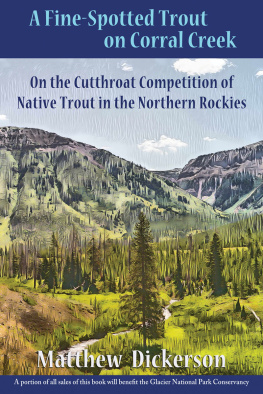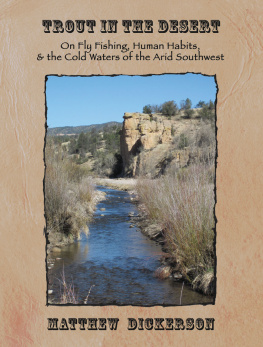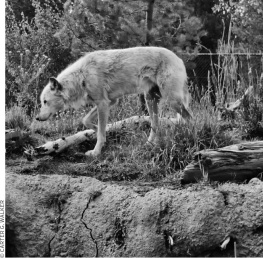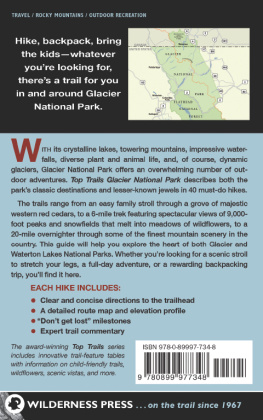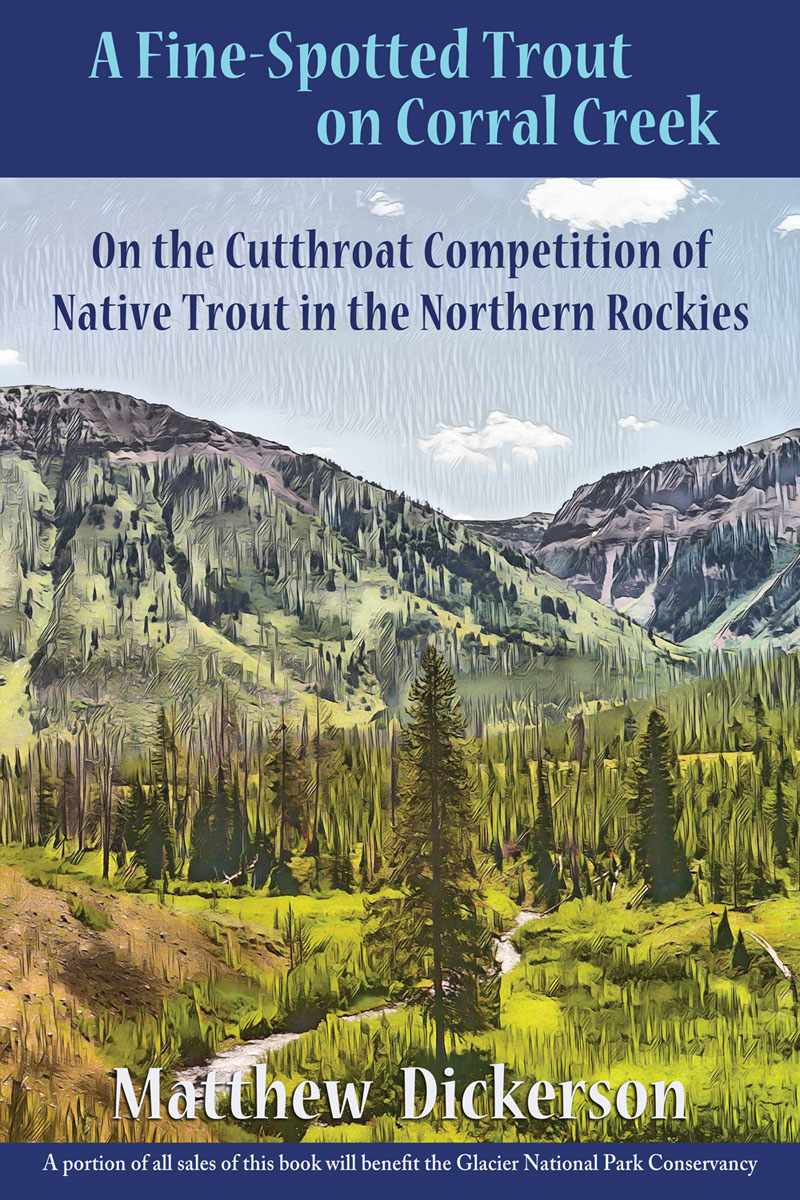

To the Reader
Annually, over three million people visit Glacier National Park. Private donations help to fill in the gap between the needs of the park and dwindling federal funding.
Glacier National Park Conservancy is the parks official fundraising nonprofit partner. GNPC supports important research, education, and wilderness preservation projects. Its mission assures that the park will remain a national treasure for generations to come.
Visit glacier.org to learn more about the Conservancy.
All royalties earned from the sale of A Fine-Spotted Trout on Corral Creek will be matched by the publisher and donated to the Glacier National Park Conservancy.
A Fine-Spotted Trout on Corral Creek: On the Cutthroat Competition of Native Trout in the Northern Rockies
2021 by Matthew Dickerson
Cover art and interior images based on photographs by Matthew Dickerson. All rights reserved.
First Edition
ISBN: 978-1-60940-617-2
E-books:
ISBN: 978-1-60940-618-9
Wings Press
P.O. Box 591176
San Antonio, Texas 78259
Wings Press books are distributed to the trade by
Independent Publishers Group
www.ipgbook.com
Due to the 2020 pandemic, no Library of Congress cataloging-in-publication data was available.
Video essays related to the written narrative essays in this book may be viewed at the Trout Downstream and Heart Streams YouTube channel through the playlist Wild and Native Cutthroat Trout: www.youtube.com/playlist?list=PLmBeEX5ze8prdtENoPRqT7P6G24Wt8Q9J.
Contents
I have been hardly more than a wandering explorer (or trespasser) in the land, full of wonder but not of information.
J.R.R. Tolkien
On Fairy-Stories
In a way, people learn best when information enters through their peripheral vision, out of the corner of their eye, not viewed directly head-on, but through stories. Native trout can return to their streams only when people view their existence as essential to their lives. And this can only happen if we see and touch these amazing creatures for ourselves.
Kurt Fausch
For the Love or Rivers:
A Scientists Journey
Prologue:A Wandering Explorer and a Short Primer on Cutthroat
This book is about cutthroat trout, a biological icon of the western United States known by the scientific classification Oncorhynchus clarkii. More particularly, it is about the native cutthroat trout inhabiting the Rocky Mountains of Montana and Wyoming. It is also about the places where they live, especially the national parks and national forests where they have been afforded a measure of conservation, preservation, and even restoration found in few other places on the continent. The essays are set mostly in Glacier National Park and Flathead National Forest in Montana, and in Yellowstone National Park, Bridger-Teton National Forest, and Shoshone National Forest in Wyoming. Because of these specific locations, the most important characters in the stories are Westslope cutthroat trout (O. c. lewisii), Yellowstone cutthroat trout (O. c. bouvierii), and Snake River Fine-Spotted cutthroat trout (O.c.behnkei), though Colorado River cutthroat (O. c. pleuriticus) also make a cameo appearance as do a native species of char (Salvelinus) commonly known as bull trout (S. confluentus). Many non-native trout also make appearances, but thats usually not a good thing, as we will see.
In some locales, such as Yellowstone Lake, cutthroat trout are not just protagonists of these stories; they are characters of a much grander narrative: a keystone species around which whole ecosystems have co-evolved.
I might have placed a book about cutthroat trout in a different part of the continent, and told stories about Rio Grande or Greenback cutthroat in the southern Rockies, or Bonneville or Lahontan cutthroat in the watershed of Utahs Great Basin. I might have told stories about Bear Lake or Paiute or Humboldt cutthroat. I might even have written about diadromous Coastal cutthroat in the Pacific northwest. Those stories would have been different in many ways, but similar in others. Stories about native cutthroat trout could be set over a large portion of the United States and Canada with similar themes weaving through them. It is believed that at one time, cutthroat were the second most widely distributed species of salmonid in North Americasecond only to lake trout (another species of char, like the bull trout). One now-extinct strain of cutthroat trout, the Lahontan cutthroat of Nevadas Pyramid Lake, was likely the largest native trout on the continent.
Several rivers are also important characters in these narratives. And since the rivers are characters, so also are the lakes the rivers flow into and out of, as well as the forests, mountains, beaver ponds, and alpine meadows through which they flow. Fisheries biologist Kurt Fausch, in his enjoyable and fascinating book For the Love of Rivers: A Scientists Journey, makes this ecological point clearly and succinctly: Everything is connected. He goes on to explain: One can no more understand a landscape by focusing only on one part than one can appreciate a landscape painting by Though the metaphor may have a valuable literal meaning, Fausch isnt primarily giving a lesson on art, but rather making an important point about rivers and ecology:
And so it is with riverscapes, a term we and other scientists have used to highlight similar hierarchies and connections within streams and between streams and their riparian forests and grasslands. Just as for landscapes, understanding riverscapes requires a continuous view of rivers to learn how features at larger spatial scales such as the geology and topography along entire river segments set the context for those at the smaller scales like riffles and pools.
Although, as an angler, my thoughts are eventually drawn to the riffles and pools, I should point out that to understand a riverscape with a continuous view one needs to include the terrestrial landscapes through which the river flows in addition to the larger fluvial scale of entire river segments. Riverscapes and landscapesthe aquatic and the terrestrialare intimately intertwined, just as lacustrine and fluvial ecologies are, and even marine ecosystems and freshwater ecosystems. What happens in the forest dramatically impacts the streams that flow through the forest (even many miles away), and what happens in the river impacts the forest through which it flows (even many miles away). Fauschs book does a wonderful job explaining and elucidating those connections, especially between forest and stream.
All of this is just another way of saying, again, that everything is connected; we all live downstream of one another. Even those who live upriver, also metaphorically live downstream (as the following narratives about cutthroat trout hopefully make clear); since trout swim upstream, often traveling great distances to spawn or colonize new water, whatever impacts a river (and its native fish) in one location can have repercussions a long distance away both upriver and down, and that impact can carry deep into surrounding forests. The researching and writing of this book helped bring that truth home to me in newand at times soberingways.
Other characters in this story include several fisheries biologists who study and care about cutthroat trout and other native fish, and the places those fish make their homes. I have had the privilege not only of reading, learning from, and teaching from Fauschs excellent book mentioned above, but also of spending time with the man himselfincluding time on a little native cutthroat trout stream wandering through an alpine meadow in a national forest in the Rocky Mountains of his home state of Colorado, I with my fly rod and Kurt with his Tenkara rod, and both of us with very small flies. My understanding of cutthroat trout and their habitat has also been informed by spending time with National Park Service biologist Christopher Downs in Glacier National Park and USGS biologist Clint Muhlfeld in Glacier National Park and Flathead National Forests, and by reading their important scientific studies. And further south in Wyoming, I enjoyed and benefited from spending time traipsing through the Shoshone National Forest with USFS biologist Shawn Anderson discussing the protection and restoration of native trout, and also interviewing USFS biologist Matt Anderson (who at the time was stationed in Bridger-Teton National Forest) about a project to restore native Colorado River cutthroat to a headwater tributary of the Colorado.
Next page
